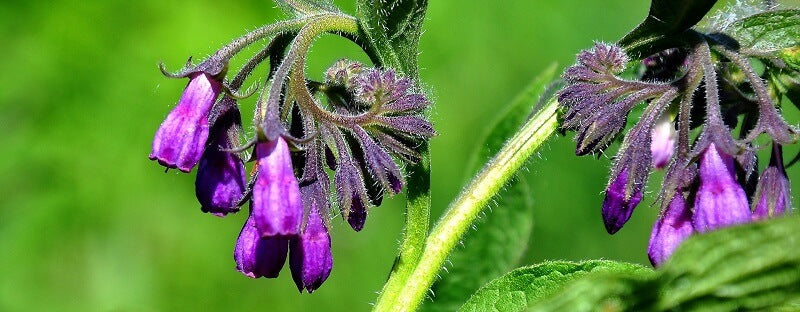Comfrey root - its uses and properties
Comfrey root has long been used in herbal medicine. In folk tradition, it has evolved into a plant with almost miraculous properties, accelerating bone fusion and the healing of other injuries. Although it is now known that comfrey's effects are not as potent as originally thought, it is still used as a supportive treatment for sprains, bruises, and skin lesions. Comfrey root owes its effectiveness to its content of vitamins, minerals, and substances that have proven very helpful in supporting skin cell regeneration—but not only that.
How and when do you use comfrey root correctly ?
The flowers and comfrey root are most commonly used, due to their high concentration of valuable substances. In the past, comfrey infusion was primarily used as a digestive aid. However, the high content of pyrrolizidine alkaloids (actually toxins) means that consuming comfrey can intensely stimulate the cerebral cortex and central nervous system, which can prove harmful to the body over time. Currently, comfrey root is intended only for external use—for skincare purposes and to support post-traumatic recovery.
As for the best uses of comfrey root, it's worth emphasizing that a properly prepared decoction, as well as the plant fragments themselves, can be used in many different ways. Comfrey is commonly known for its beneficial effects on the skin. The decoction is used as a bath additive. After straining the liquid, the remaining plant matter can be mixed with unrefined oil—for example, linseed, hemp, or olive—to create a moisturizing ointment.
It supports the healing of minor wounds and helps combat calluses, scars, and other skin lesions. All this is due to the presence of choline (which helps seal blood vessel walls), a high content of tannins, minerals, B vitamins, and vitamins A, C, and E. The rosmarinic acid contained in comfrey has anti-inflammatory properties, which facilitates the healing of minor wounds.
Natural Comfrey Root - Other Uses
There are other uses for comfrey root – tincture is one of them, especially recommended for rheumatic and joint pain. An alcohol-based tincture is perfect for warming sore spots, as it quickly penetrates the skin, making it a successful compress.
However, the most popular use of comfrey root is to support the healing of injuries such as bruises, sprains, strains, or broken bones. Allantoin is another substance found in this plant that actively supports the regeneration of tissues, including bones. Its effects are valued for its ability to accelerate the renewal and formation of new cells by stimulating blood circulation and more effectively filling defects in tissue structure.
When prepared as needed, comfrey root provides natural support for both recovery and maintenance treatments. It's an excellent option for people looking for cost-effective and natural solutions. However, when using comfrey preparations or preparing your own, it's worth planning the treatment to last longer than 4-6 weeks.
THE PUBLISHER'S CHOICE
Almonds 1 kg BIOGO
- €11,69
€13,75- €11,69
- Unit price
- / per
Walnuts 800 g BIOGO
- €8,65
€10,18- €8,65
- Unit price
- / per
Dried organic mango 400 g BIOGO
- €10,99
- €10,99
- Unit price
- / per
Dried White Mulberries 500 g ORGANIC
- €5,84
€6,87- €5,84
- Unit price
- / per
Dried organic figs 800 g BIOGO
- €30,12
- €30,12
- Unit price
- / per
Unpeeled buckwheat groats 1 kg BIOGO
- €2,81
€3,31- €2,81
- Unit price
- / per
Organic coconut flakes 500 g BIOGO
- €10,07
- €10,07
- Unit price
- / per
Organic oat flakes 600 g BIOGO
- €3,77
- €3,77
- Unit price
- / per
Organic cashew nuts 1 kg BIOGO
- €19,99
- €19,99
- Unit price
- / per
Milk thistle seeds 1 kg BIOGO
- €3,99
- €3,99
- Unit price
- / per









































































































































